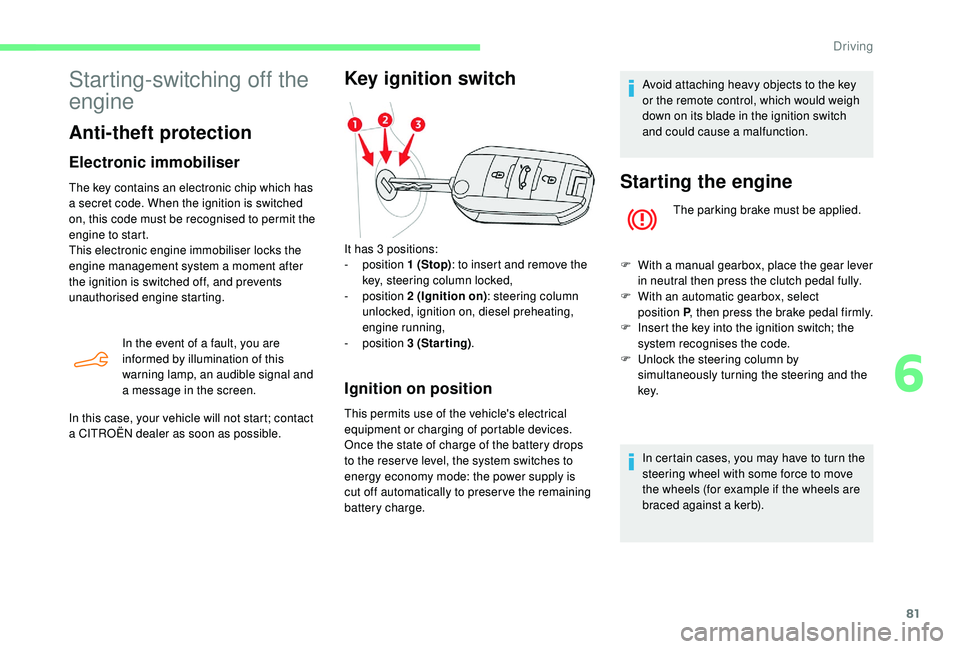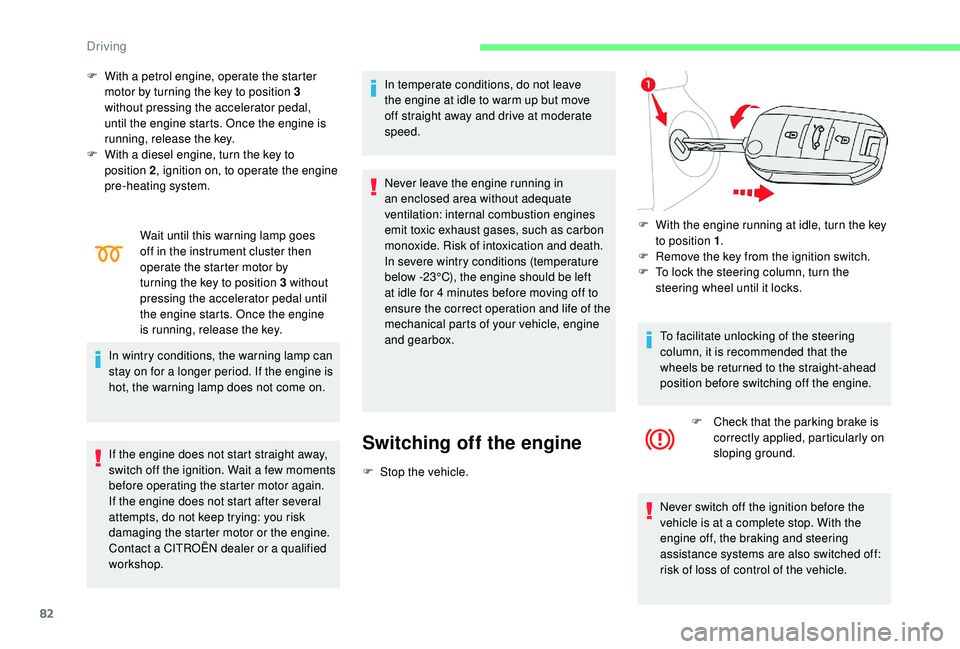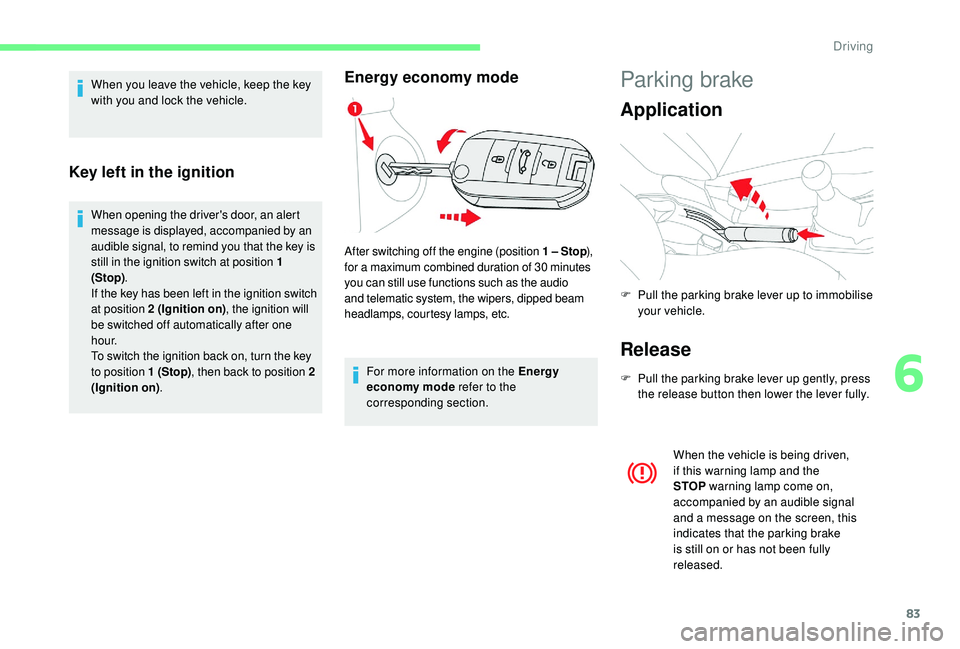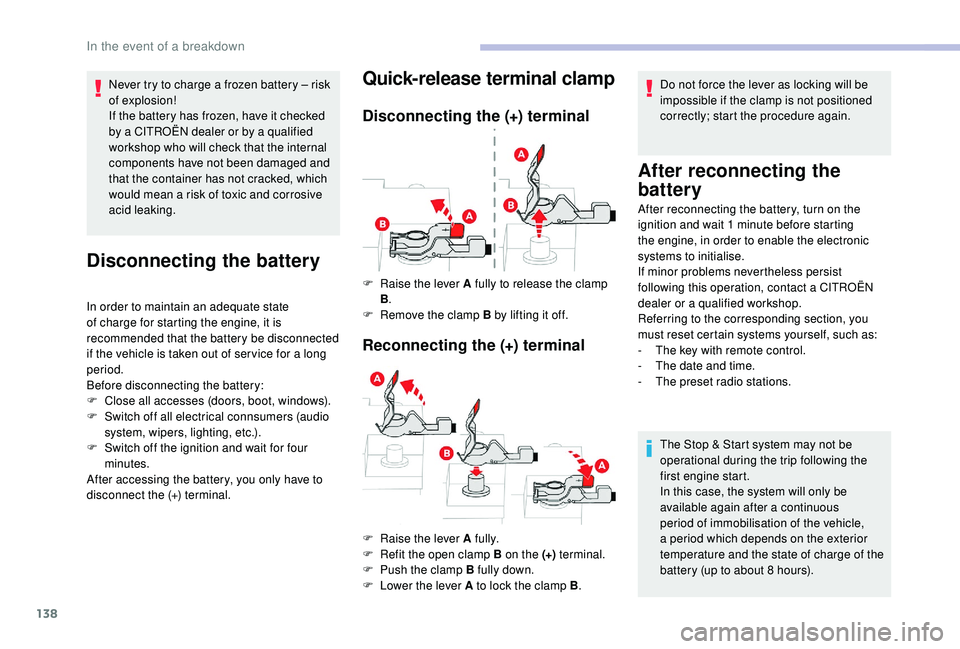key CITROEN C-ELYSÉE 2018 Handbook (in English)
[x] Cancel search | Manufacturer: CITROEN, Model Year: 2018, Model line: C-ELYSÉE, Model: CITROEN C-ELYSÉE 2018Pages: 260, PDF Size: 8.4 MB
Page 72 of 260

70
Deactivating the
passenger's front airbag
Never install a "rear ward facing" child
restraint system on a seat protected by
an activated front airbag. This can cause
death or serious injury to the child.
Passenger airbag OFF
Deactivation
When the ignition is on, this warning
light comes on in the instrument
panel and stays on while the airbag
is deactivated.
To assure the safety of your child,
the passenger's front airbag must be
deactivated when you install a "rear ward
facing" child seat on the front passenger
seat. Otherwise, the child risks being
seriously injured or killed if the airbag is
deployed.
Reactivation
When you remove the "rear ward facing" child
seat, with the ignition off , turn the switch to
the ON position to reactivate the airbag and so
assure the safety of your front passenger in the
event of an impact.
The warning label, located on each side of the
passenger sun visor repeats this advice. This label is located on the middle door pillar,
passenger side. In line with current legislation, you will find this
warning in all the required languages in the
following tables.
Only the passenger's front airbag can be
deactivated.
F
W
ith the ignition off , insert the key into the
passenger airbag deactivation switch. F
T
urn it to the "OFF" position.
F
R
emove the key keeping the switch in this
position.
Safety
Page 80 of 260

78
Advice
The incorrect installation of a child seat in a
vehicle compromises the child's protection in
the event of an accident.
Check that there is no seat belt or seat belt
buckle under the child seat as this could
make it unstable.
Remember to fasten the seat belts or the
child seat harnesses keeping the slack
relative to the child's body to a minimum,
even for short journeys.
When installing a child seat using the seat
belt, ensure that the seat belt is tightened
correctly on the child seat and that it secures
the child seat firmly on the seat of your
vehicle. If your passenger seat is adjustable,
move it for wards if necessary.
In the rear, always leave sufficient space
between the front seat and:
-
a "
rear ward facing" child seat,
-
t
he feet of a child seated in a "for ward
facing" child seat.
For this, move the seat for ward and, if
necessary, straighten its backrest too.
For optimal installation of the "forward facing"
child seat, ensure that its backrest is as close
as possible to the backrest of the vehicle
seat, if possible in contact with it. The head restraint must be removed before
installing a child seat with a backrest on a
passenger seat.
Ensure that the head restraint is stored or
attached securely to prevent it from being
thrown around the vehicle in the event of
sharp braking. Refit the head restraint once
the child seat has been removed.
CITROËN recommends using a booster seat
with a backrest, equipped with a belt guide at
shoulder level.
As a safety precaution, do not leave:
-
a c
hild or children alone and unattended in
a vehicle,
-
a c
hild or an animal in a vehicle exposed
to the sun, with the windows closed,
-
t
he keys within the reach of children inside
the vehicle.
To prevent accidental opening of the doors
and rear windows, use the child lock.
Take care not to open the rear windows by
more than one third.
To protect young children from the rays of the
sun, fit side blinds on the rear windows.
Children in the front
The legislation on carrying children on the
front passenger seat is specific to each
country. Refer to the legislation in force in
your country.
Deactivate the passenger's front airbag when
a "rear ward facing" child seat is installed on
the front passenger seat.
Otherwise, the child risks being seriously
injured or killed if the airbag is deployed.
Installing a booster seat
The chest part of the seat belt must be
positioned on the child's shoulder without
touching the neck.
Ensure that the lap part of the seat belt
passes correctly over the child's thighs.
Safety
Page 81 of 260

79
Manual child lock
Mechanical system to prevent opening of a rear
door using its interior control.
Locking
Unlocking
F With the ignition key, turn the red control one quarter of a turn:
-
T
o the left on the left-hand rear door.
-
T
o the right on the right-hand rear door.
The control is located on the edge of each rear
d o o r.
F
W
ith the ignition key, turn the red control
one quarter of a turn:
-
T
o the right on the left-hand rear door.
-
T
o the left on the right-hand rear door.
5
Safety
Page 83 of 260

81
Starting-switching off the
engine
Anti-theft protection
Electronic immobiliser
The key contains an electronic chip which has
a secret code. When the ignition is switched
on, this code must be recognised to permit the
engine to start.
This electronic engine immobiliser locks the
engine management system a moment after
the ignition is switched off, and prevents
unauthorised engine starting.In the event of a fault, you are
informed by illumination of this
warning lamp, an audible signal and
a message in the screen.
In this case, your vehicle will not start; contact
a CITROËN dealer as soon as possible.
Key ignition switch
Ignition on position
This permits use of the vehicle's electrical
equipment or charging of portable devices.
Once the state of charge of the battery drops
to the reser ve level, the system switches to
energy economy mode: the power supply is
cut off automatically to preser ve the remaining
battery charge. Avoid attaching heavy objects to the key
or the remote control, which would weigh
down on its blade in the ignition switch
and could cause a malfunction.
Starting the engine
The parking brake must be applied.
F
W
ith a manual gearbox, place the gear lever
in neutral then press the clutch pedal fully.
F
W
ith an automatic gearbox, select
position P , then press the brake pedal firmly.
F
I
nsert the key into the ignition switch; the
system recognises the code.
F
U
nlock the steering column by
simultaneously turning the steering and the
key.
In certain cases, you may have to turn the
steering wheel with some force to move
the wheels (for example if the wheels are
braced against a kerb).
It has 3
positions:
-
position 1
(Stop) : to insert and remove the
key, steering column locked,
-
position 2
(Ignition on) : steering column
unlocked, ignition on, diesel preheating,
engine running,
-
position 3
(Starting) .
6
Driving
Page 84 of 260

82
F With a petrol engine, operate the starter motor by turning the key to position 3
without pressing the accelerator pedal,
until the engine starts. Once the engine is
running, release the key.
F
W
ith a diesel engine, turn the key to
position 2 , ignition on, to operate the engine
pre-heating system.
Wait until this warning lamp goes
off in the instrument cluster then
operate the starter motor by
turning the key to position 3
without
pressing the accelerator pedal until
the engine starts. Once the engine
is running, release the key.
In wintry conditions, the warning lamp can
stay on for a longer period. If the engine is
hot, the warning lamp does not come on.
If the engine does not start straight away,
switch off the ignition. Wait a few moments
before operating the starter motor again.
If the engine does not start after several
attempts, do not keep trying: you risk
damaging the starter motor or the engine.
Contact a CITROËN dealer or a qualified
workshop. In temperate conditions, do not leave
the engine at idle to warm up but move
off straight away and drive at moderate
speed.
Never leave the engine running in
an enclosed area without adequate
ventilation: internal combustion engines
emit toxic exhaust gases, such as carbon
monoxide. Risk of intoxication and death.
In severe wintry conditions (temperature
below -23°C), the engine should be left
at idle for 4
minutes before moving off to
ensure the correct operation and life of the
mechanical parts of your vehicle, engine
and gearbox.
Switching off the engine
F Stop the vehicle. F
W
ith the engine running at idle, turn the key
to position 1 .
F
R
emove the key from the ignition switch.
F
T
o lock the steering column, turn the
steering wheel until it locks.
To facilitate unlocking of the steering
column, it is recommended that the
wheels be returned to the straight-ahead
position before switching off the engine. F
C
heck that the parking brake is
correctly applied, particularly on
sloping ground.
Never switch off the ignition before the
vehicle is at a complete stop. With the
engine off, the braking and steering
assistance systems are also switched off:
risk of loss of control of the vehicle.
Driving
Page 85 of 260

83
When you leave the vehicle, keep the key
with you and lock the vehicle.
Key left in the ignition
When opening the driver's door, an alert
message is displayed, accompanied by an
audible signal, to remind you that the key is
still in the ignition switch at position 1
(Stop).
If the key has been left in the ignition switch
at position 2
(Ignition on) , the ignition will
be switched off automatically after one
h o u r.
To switch the ignition back on, turn the key
to position 1
(Stop), then back to position 2
(Ignition on) .
Energy economy mode
For more information on the Energy
economy mode refer to the
corresponding section.
After switching off the engine (position 1 – Stop
),
for a maximum combined duration of 30 minutes
you can still use functions such as the audio
and telematic system, the wipers, dipped beam
headlamps, courtesy lamps, etc.
Parking brake
Application
Release
F Pull the parking brake lever up gently, press the release button then lower the lever fully.
When the vehicle is being driven,
if this warning lamp and the
STOP warning lamp come on,
accompanied by an audible signal
and a message on the screen, this
indicates that the parking brake
is still on or has not been fully
released.
F
P
ull the parking brake lever up to immobilise
your vehicle.
6
Driving
Page 92 of 260

90
If the engine is in STOP mode, it restarts
immediately.
The Stop & Start system is reactivated
automatically every time the ignition is switched
on.
With button
Press this button to deactivate the system.
Deactivation is confirmed by the illumination of
the button indicator lamp and the display of a
message.
Pressing this button again reactivates the
function.
The button indicator lamp goes off and a
message is displayed.
With touch screen
The Stop & Start setting can be
configured in the menu Driving /
Vehicle. Opening the bonnet
Before doing anything under the bonnet,
deactivate the Stop & Start system to
avoid the risk of injury related to an
automatic change to START mode.
Driving on flooded roads
Before driving through a flooded road, it is
strongly recommended that you deactivate
the Stop & Start.
For more information on Driving
recommendations
, particularly on
flooded roads, refer to the corresponding
section.
Malfunction
In the event of a fault in the system,
the indicator lamp in the "ECO OFF"
button flashes for a moment, then
illuminates continuously.
Have them checked by a CITROËN dealer or a
qualified workshop. In the event of a fault in STOP mode, the
vehicle may stall. All of the instrument panel
warning lamps come on. It is then necessary to
switch the ignition off and to restart the engine
using the key.
The Stop & Start system requires a
12 V battery of specific technology and
specification.
All work on this type of battery must be
carried out only by a CITROËN dealer or a
qualified workshop.
For more information on the 12 V batter y
,
refer to the corresponding section.
Driving
Page 107 of 260

105
Procedure
Before topping up, ensure that the vehicle is
parked on a flat and level sur face.
In wintry conditions, ensure that the
temperature of the vehicle is above -11°C.
Otherwise the AdBlue
® may freeze and so
cannot be poured into its tank. Park your
vehicle in a warmer area for a few hours to
allow the top-up to be carried out.
F
S
witch off the ignition and remove the key.
F
U
nclip the plastic valve. F
C
arefully lift off the cap, without letting go
of it.
F
F
or access to the AdBlue
® tank, open the
boot, remove the boot floor and then lift out
the storage box containing the tools.
F
I
nsert your fingers into the aperture and turn
the blue cap 1/6
th of a turn anti-clockwise. F
G
et a bottle of AdBlue
®. After first checking
the use-by date, read the instructions on
use on the label carefully before pouring
the contents of the bottle into your vehicle's
AdBlue
® tank.
Important: if your vehicle's AdBlue
® tank is
completely empty – which is confirmed by
the alert displays and the impossibility of
starting the engine – you must add at least
3.8
litres (so two 1.89
litre bottles).
F
A
fter emptying the bottle, wipe away any
spillage around the tank filler using a damp
cloth. If any additive is spilt or splashed, wash
immediately with cold water or wipe with a
damp cloth.
If the additive has crystallised, clean it off
using a sponge and hot water.
F
R
efit the blue cap to the tank and turn it 1/6
th
of a turn clockwise, to its stop.
F
R
eplace the plastic valve, clipping it in the
opening.
F
R
eturn the storage box containing the tools
to its location.
F
R
eplace the boot floor and close the boot. Never dispose of AdBlue
® additive
bottles in the household waste. Place
them in a container provided for this
purpose or take them to your dealer.
Important: if topping up after
running out of Adblue , you must wait
approximately 5 minutes before switching
on the ignition, without opening the
driver's door , unlocking the vehicle or
inser ting the key in the ignition .
Switch on the ignition, then, after
10
seconds, start the engine.
7
Practical information
Page 140 of 260

138
Never try to charge a frozen battery – risk
of explosion!
If the battery has frozen, have it checked
by a CITROËN dealer or by a qualified
workshop who will check that the internal
components have not been damaged and
that the container has not cracked, which
would mean a risk of toxic and corrosive
acid leaking.
Disconnecting the battery
In order to maintain an adequate state
of charge for starting the engine, it is
recommended that the battery be disconnected
if the vehicle is taken out of ser vice for a long
period.
Before disconnecting the battery:
F
C
lose all accesses (doors, boot, windows).
F
S
witch off all electrical connsumers (audio
system, wipers, lighting, etc.).
F
S
witch off the ignition and wait for four
minutes.
After accessing the battery, you only have to
disconnect the (+) terminal.
Quick-release terminal clamp
Disconnecting the (+) terminal
Reconnecting the (+) terminal
Do not force the lever as locking will be
impossible if the clamp is not positioned
correctly; start the procedure again.
After reconnecting the
battery
F Raise the lever A fully to release the clamp B.
F
R
emove the clamp B by lifting it off.
F
Ra
ise the lever A fully.
F
R
efit the open clamp B on the (+) terminal.
F
P
ush the clamp B fully down.
F
L
ower the lever A to lock the clamp B .After reconnecting the battery, turn on the
ignition and wait 1
minute before starting
the engine, in order to enable the electronic
systems to initialise.
If minor problems nevertheless persist
following this operation, contact a CITROËN
dealer or a qualified workshop.
Referring to the corresponding section, you
must reset certain systems yourself, such as:
-
T
he key with remote control.
-
T
he date and time.
-
T
he preset radio stations.
The Stop & Start system may not be
operational during the trip following the
first engine start.
In this case, the system will only be
available again after a continuous
period of immobilisation of the vehicle,
a period which depends on the exterior
temperature and the state of charge of the
battery (up to about 8
hours).
In the event of a breakdown
Page 142 of 260

140
Towing another vehicle
This type of towing is strictly prohibited
(risk of damage to your vehicle).
F
U
nlock the steering by turning the ignition
key one notch and release the parking
brake.
F
S
witch on the hazard warning lamps on
both vehicles.
F
S
et off gently, drive slowly and for a short
distance.
In the event of a breakdown